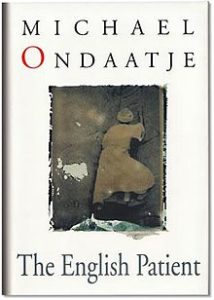
It’s been brought to our attention that both Michael Ondaatje’s Booker and Golden Booker Prize-winning novel The English Patient, and its Oscar-winning 1996 film adaptation, are back in the news (and I use the term “news” in the loosest possible sense) this week after Sarah Miller’s essay “The Movie Assassin: How The English Patient Ruined My Life” took book/movie criticism/alt-weekly twitter by storm.
Turns out people have some strong opinions on whether The English Patient, in either of its incarnations, is “perfumed gruel” or “a delicate grisaille of memory and passion.” So which is it? Well, we can’t give you the 2018 consensus (we’ll leave that to the cyborg editors of Future Book Marks), but we what we can do is excavate some of the earliest criticism of the novel from way back in the dim and distant past to try and help you decide for yourselves.
The year was 1992: a teflon Arkansas governor by the name of Bill Clinton was about to deny future Simpsons guest star George H. W. Bush a second term, Sinéad O’Connor had recently torn up a picture of Pope John Paul II on Saturday Night Live, and all across America people were reading about a horribly burned WWII fighter pilot recounting his life story from his death bed in an Italian villa…
*

We die containing a richness of lovers and tribes, tastes we have swallowed, bodies we have plunged into and swum up as if rivers of wisdom, characters we have climbed into as if trees, fears we have hidden in as if caves.
*
“There’s the suggestion of a classic espionage thriller in this angle of the plot, but Mr. Ondaatje is after something else—a narrative reflection, perhaps, on the alternate exhilarations and terrors of life in wartime. Through interlaced scenes, each saturated with emotion, he uncovers the inner passions of his characters: Hana’s grief over her father’s death earlier in the war; Caravaggio’s mourning for his lost vocation; Singh’s terrifying exploits with the bomb squad; the nameless patient’s pride in his memories of love. Their stories take us to extraordinary times and places, from muddy craters where giant ‘Satan’ bombs are delicately disarmed by hand under unsteady flashlights, to hidden rock paintings in desert caves.
Mr. Ondaatje’s acknowledgments testify to his meticulous research, and the kinesthetic vitality of his descriptions bears it out. He makes the technical maze of delayed fuses and disguised wiring about as compelling as can be imagined outside of the professional situation itself.
In contrast to the brilliant short takes of explorers, spies and army sappers probing minefields, the drama of emotions among the main characters seems much less dynamic. Certainly they come well garlanded with attributes—Hana’s reticent tenderness, her patient’s iron self-discipline, his lover’s arrogant beauty—but the effect produced is of figures fixed in a mosaic, icons representing in turn innocence, passion, loss and endurance. When they talk together, they have a tendency toward melodramatic statements in very formal language (but then one thinks, was there once a time when people finished all their sentences in good order?).
…
“Nonetheless, The English Patient, which was named a co-winner of the 1992 Booker Prize last month, is a tale of many pleasures—an intensely theatrical tour de force, but grounded in Michael Ondaatje’s strong feeling for distant times and places.”
–Judith Grossman, The New York Times, November 1, 1992
*

“Michael Ondaatje has invented a way of writing a novel that approximates the mind’s habit of coming back again and again to the same moments of ecstasy, shame, peril or slipped meanings. Robbe-Grillet pointed the way towards this form in Jealousy, but in a much more austere and impersonal style. Like coral, Ondaatje’s narrative is built up slowly into towers and branches and hidden chambers, fashioning a delicate grisaille of memory and passion.
…
“This is not the poetic prose of false sentiment and highfalutin’ diction, rather the true lyricism of fact, myth and tragic vision. Sometimes the metaphors are very simple (‘He leaned against the corner of the vestibule like a spear’). There are passages about the desert worthy of Arabia Deserta, passages about defusing a bomb worthy of a professional treatise. The running narrative tone has a majestic, almost Biblical cadence to it, but one that can assimilate all the details of modern life, from air pillows to land mines.
Many books—The Bible, Alice in Wonderland, Peter Pan and Kim—work their way into the texture of The English Patient, along with pop songs and poetry. Hana writes her thoughts about Caravaggio on a blank page in The Last of the Mohicans; the English Patient pastes new pages, covered with his own writing, into his battered Herodotus; he falls in love with Katherine in a mechanism drawn directly from Stendhal’s theory of love ‘crystallisation.’
This is the best piece of fiction in English I’ve read in several years, idiosyncratic but sturdy, and throbbing with emotion and humanity.”
–Edmund White, The Independent, September 19, 1992
*

“Ondaatje is one of those writers who prefer to make their characters reveal themselves through ordeals, not ordinary life. One of the four characters he places in a bomb-ruined Italian villa at the end of World War II has been burned beyond recognition, left with only his English-accented voice and his stark stories of the North African desert where his plane crashed. Another, a 20-year-old Canadian nurse named Hana, has been numbed by caring for dying men but has found a new vocation in her devotion to ‘the English patient.’ The third has been given the name of the 16th-century Italian painter who used thieves and prostitutes as models for his paintings of sacred subjects. This Caravaggio is a Canadian. He had been a thief before the war. He has spent the war in the same profane profession, stealing for the sacred Allied cause. The fourth character is Kirpal Singh, or Kip, an Indian who joined the British army and was trained as a sapper, an expert in disassembling the unexploded bombs that litter England and Italy. He is therefore in constant danger of being blown to bits.
Nothing so explosive happens. Caravaggio admits he’s in love with Hana. She develops a delicate passion for Kip. But the life of the book is in the desert, where the burned man had been an explorer before the war and where he had fallen into a destructive affair with the wife of a colleague. His stories aren’t entirely believable, but they become compelling because the desert comes through with its oases and mysteries intact. The novel finally succeeds as a celebration of the solitude to be found in deserts, dangerous machines, and unrequited love, and as a celebration of the impassioned individuality that seeks such solitude.”
–L.S. Klepp, Entertainment Weekly, November 20, 1992
*

